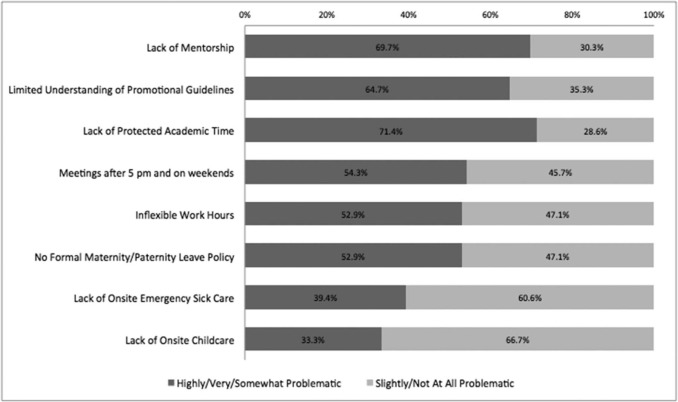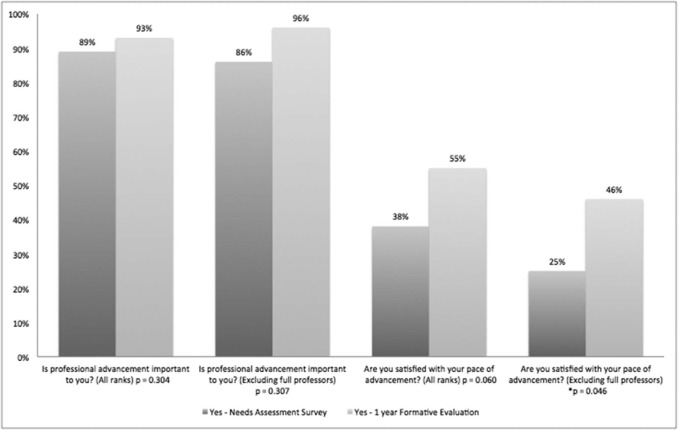Rationale and Objectives
Women are under-represented in the field of radiology, occupy a minority of leadership positions, and, at our institution, have not achieved the same level of academic success as their male counterparts. Consequently, the authors designed, implemented, and evaluated the Leadership Intervention to Further the Training of Female Faculty (LIFT-OFF) program to (1) improve access to opportunities for women’s faculty development and advancement, and (2) improve clarification of expectations about the role and path of advancement.
Materials and Methods
LIFT-OFF was developed based on the results of a needs assessment survey. The results generated 14 priority topics, which served as the basis for educational modules conducted by expert speakers. Module effectiveness was assessed with pre- and postsurveys to elicit participant knowledge about the targeted subject matter. A formative program evaluation was performed at the completion of year 1 of 2 to assess outcomes and impacts to date.
Results
Seventeen of 55 (31%) educational module post-survey questions demonstrated a statistically significant ( P < 0.05) increase in “yes” responses, indicating an improved understanding of targeted information. At year 1, 75% of the participants indicated that the program improved access to faculty development opportunities and 62% reported improved access to career advancement opportunities. Satisfaction with pace of professional advancement increased from 25% to 46% for junior women faculty ( P = 0.046).
Conclusions
Faculty development programs such as LIFT-OFF can provide career development opportunities and executive skills necessary for women to achieve academic career success and assume leadership positions.
Introduction
Data from the Association of American Medical College’s Faculty Forward Engagement Survey suggest that for women faculty to be successful, they should benefit from (1) clear expectations about the role and path of advancement, (2) an equitable and diverse workplace, and (3) access to opportunities for development and advancement . Likewise, substantive improvements in the development of women’s careers and success in retaining women faculty were demonstrated after the implementation of a “Career Development for Women in Academic Medicine” program in the Department of Medicine at Johns Hopkins University. More importantly, this intervention was found to benefit not only the women faculty, but all faculty members .
Women remain under-represented in radiology (22% of radiologists are women) despite steady parity of gender enrollment in medical school over the past 10 years (46% of enrollees are women) . As an additional concern, women occupy a minority of radiology leadership positions, with only 7% of leaders being women. The last 10 years has seen a minimal increase in the number of women program directors and virtually no increase in the number of chairwomen . This lack of women in leadership positions may result in a lack of role models to attract women medical students. For many women in internal medicine and surgery, access to female role models played a large role in the determination of specialty choice . Additionally, analysis of women medical students’ interest in radiology careers has demonstrated that effective role models have a direct, positive influence on interest levels in radiology careers . Increasing the number of women in leadership roles in radiology has the potential to generate an overall increase in the number of women faculty members, maintain perspective of women, and attract future generations of women radiologists. It is imperative to improve faculty development for women in radiology to retain and advance the current women in academic radiology and to attract women to the field of radiology.
Get Radiology Tree app to read full this article<
Materials and Methods
Get Radiology Tree app to read full this article<
Target Audience and Study Participants
Get Radiology Tree app to read full this article<
Needs Assessment
Get Radiology Tree app to read full this article<
Program Development
Get Radiology Tree app to read full this article<
Table 1
Module Topics
Topics Understanding of Promotional Guidelines Developing Your Educational Portfolio Enhancing Your CV Work-Life Balance Time Management and Organizational Skills Meeting the Challenges of Academic Career Building What’s Holding You Back? Clinical Investigation Writing/Reviewing for Medical Journals Writing Proposals and Winning Research Grants Conflict Management Moving Into Administrative, Leadership, and Policy-making Roles Maximizing Your Professional Advancement Options The Art of Self-promotion
CV, curriculum vitae.
Get Radiology Tree app to read full this article<
Get Radiology Tree app to read full this article<
Get Radiology Tree app to read full this article<
Table 2
Modules Completed in Year 1
Module Name Expert Speaker Speaker Gender Number of Participants Completing the Premodule Survey Number of Participants Who Attended the Module Completing the Postmodule Survey (Total Number Completing the Survey) Understanding of Promotional Guidelines Department of Radiology Chair Male 29 16 (26) Work-Life Balance Senior Faculty, Department of Surgery Female n/a n/a Developing Your Educational Portfolio Director, Educator Development Program Female 29 11 (19) Promotion and Tenure Guidelines Assistant Dean for Faculty Development, Medical Center Male n/a n/a Writing/Reviewing for Medical Journals Senior Faculty, Department of Radiology, Journal Editor Female 21 12 (17) Enhancing Your CV Vice Chair for Faculty Affairs, Department of Pediatrics Male 16 11 (18) Career Paths for Nurse Practitioners Assistant Dean for Faculty Development, Medical Center Male n/a n/a Moving into Administrative, Leadership, and Policy-making Roles Chief of Staff and Executive Medical Director of Children’s Hospital Female 17 13 (18)
CV, curriculum vitae; n/a, not applicable.
Get Radiology Tree app to read full this article<
Individual Educational Module Assessment
Get Radiology Tree app to read full this article<
Get Radiology Tree app to read full this article<
Get Radiology Tree app to read full this article<
Formative Evaluation at the End of Year 1
Get Radiology Tree app to read full this article<
Get Radiology Tree app to read full this article<
Statistical Analysis
Get Radiology Tree app to read full this article<
Ethical Considerations
Get Radiology Tree app to read full this article<
Results
Needs Assessment
Get Radiology Tree app to read full this article<
Table 3
Needs Assessment Survey—Demographics
Characteristic_n_ (%) Age (y) 30–34 3(8.8) 35–39 9(26.5) 40–44 9(26.5) 45–49 3(8.8) 50–54 2(5.9) 55–59 2(5.9) >60 6(17.6) Rank Instructor 0(0) Assistant professor 16(47.1) Associate professor 4(11.8) Professor 6(17.6) Nurse practitioner 3(8.8) Other 5(14.7) Appointment Full time 28(82.4) Part time 6(17.6) Numbers of years in academics 0–5 8(23.5) 6–10 9(26.5) 11–15 9(26.5) 16–20 3(8.8) >20 5(14.7)
Get Radiology Tree app to read full this article<
Get Radiology Tree app to read full this article<
Get Radiology Tree app to read full this article<
Get Radiology Tree app to read full this article<
Get Radiology Tree app to read full this article<
Individual Educational Module Assessment
Get Radiology Tree app to read full this article<
Table 4
Statistically Significant Individual Module Assessment Survey Questions
Survey Question_P_ Value Understanding of Promotional Guidelines Do you know where to find the institution’s standardized CV format? 0.0005 Do you know where to find the institution’s Documentation of Teaching Form? <0.0001 Do know how to establish a mentorship committee? 0.0380 Developing Your Educational Portfolio Do you know where to find the electronic teaching portfolio? 0.0050 Do you know where to find the Documentation of Teaching Form? 0.0008 Do you understand the difference in the electronic teaching portfolio and the Documentation of Teaching Form? 0.0006 Do you know how to document your teaching activities in the electronic teaching portfolio? 0.0001 Do you know how to document your teaching activities in the Documentation of Teaching Form? 0.0300 Are you provided with a format to document your yearly progress to present at a performance review? 0.0220 Writing/Reviewing for Medical Journals Do you understand which types of manuscripts are generally published by the different radiology/medicine journals ( JACR , Radiology , RadioGraphics , Academic Radiology , NEJM , etc.)? 0.0090 Do you know how to become a manuscript reviewer? 0.0220 Do you understand the manuscript review process? 0.0020 Enhancing Your CV Do you know what activities are appropriate to document on your CV? 0.0070 Do you know how to demonstrate your focus of interest on your CV? 0.0240 Administrative, Leadership and Policy-making Roles Do you know how to prepare yourself for a leadership role? 0.0002 Do you understand the leadership hierarchy of the medical center? 0.0016 Do you understand the hierarchy of the medical school? 0.0018 Do you understand who makes the medical center policies? 0.0069
CV, curriculum vitae; JACR , Journal of the American College of Radiology ; NEJM , The New England Journal of Medicine .
Get Radiology Tree app to read full this article<
Formative Evaluation at the End of Year 1
Get Radiology Tree app to read full this article<
Get Radiology Tree app to read full this article<
Get Radiology Tree app to read full this article<
Get Radiology Tree app to read full this article<
Individual Women Faculty Achievements During Year 1
Get Radiology Tree app to read full this article<
Discussion
Get Radiology Tree app to read full this article<
Get Radiology Tree app to read full this article<
Get Radiology Tree app to read full this article<
Get Radiology Tree app to read full this article<
Get Radiology Tree app to read full this article<
Get Radiology Tree app to read full this article<
Get Radiology Tree app to read full this article<
Conclusions
Get Radiology Tree app to read full this article<
Get Radiology Tree app to read full this article<
References
1. Lautenberger M.T., Dandar V.M., Raezer C.L., et. al.: The state of women in academic medicine—the pipeline and pathways to leadership.2013–2014.Association of American Medical CollegesWashington, D.C.
2. Fried L.P., Francomano C.A., MacDonald S.M., et. al.: Career development for women in academic medicine: multiple interventions in a department of medicine. JAMA 1996; 276: pp. 898-905.
3. Bluth E.I., Bansal S., Macura K.J., et. al.: Gender and the radiology workforce: results of the 2014 ACR workforce survey. J Am Coll Radiol 2015; 12: pp. 155-157.
4. Baker S.R., Bary M., Chaudry H., et. al.: Women as radiologists: are there barriers to entry and advancement?. J Am Coll Radiol 2006; 3: pp. 131-134.
5. Chaudry H., Karcich J., Thomas P., et. al.: Women as radiologists a decade later: are there still barriers to entry and advancement?. Abstract #39, ACR Summit2015.
6. Neumayer L., Kaiser S., Anderson K., et. al.: Perceptions of women medical students and their influence on career choice. Am J Surg 2002; 183: pp. 146-150.
7. McMurray J.E., Schwartz M.D., Genero N.P., et. al.: The attractiveness of internal medicine: a qualitative analysis of the experiences of female and male medical students. Ann Intern Med 1993; 119: pp. 812-818.
8. Roubidoux M.A., Packer M.M., Applegate K.E., et. al.: Female medical students’ interest in radiology careers. J Am Coll Radiol 2009; 6: pp. 246-253.
9. Kirkpatrick D.L., Kirkpatrick J.D.: Implementing the four levels: a practical guide for effective evaluation of training programs.2007.Berrett-Koehler Publishers, Inc.San Francisco, CA
10. Harris P.A., Taylor R., Thielke R., et. al.: Research electronic data capture (REDCap)—a metadata-driven methodology and workflow process for providing translational research informatics support. J Biomed Inform 2009; 42: pp. 377-381.
11. Vanderbilt University School of Medicine Educator Development Program. Available at: https://medschool.vanderbilt.edu/ohse/educator-development-program Accessed August 25, 2016
12. Kellogg W.K.: Foundation logic model development guide. Available at: https://www.wkkf.org/resource-directory/resource/2006/02/wk-kellogg-foundation-logic-model-development-guide Updated January; W.K. Kellogg Foundation. One East Michigan Avenue East. Battle Creek, Michigan 49017-4058 PDF; Accessed September 1, 2016
13. Oliva P.F.: Developing the curriculum.5th ed.2001.LongmanNew York, NY
14. StataCorp : Stata: release 14. Statistical software.2015.StataCorp LPCollege Station, TX
15. McDonald J.H.: Handbook of biological statistics.3rd ed.2014.Sparky House PublishingBaltimore, MD

